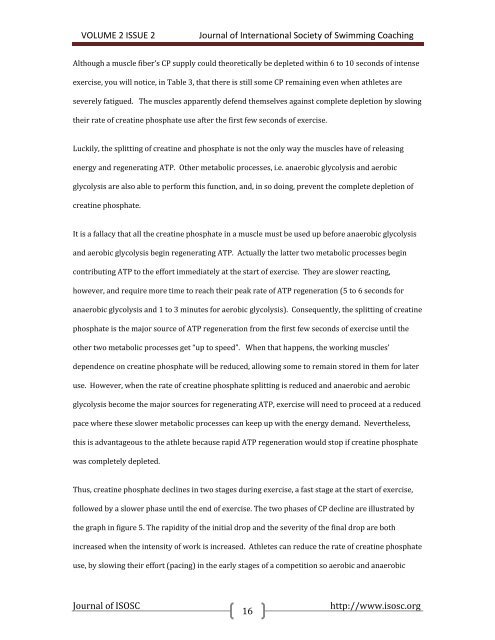Volume%202%20issue%202%20isosc
Volume%202%20issue%202%20isosc
Volume%202%20issue%202%20isosc
Create successful ePaper yourself
Turn your PDF publications into a flip-book with our unique Google optimized e-Paper software.
VOLUME 2 ISSUE 2 Journal of International Society of Swimming Coaching<br />
Although a muscle fiber’s CP supply could theoretically be depleted within 6 to 10 seconds of intense<br />
exercise, you will notice, in Table 3, that there is still some CP remaining even when athletes are<br />
severely fatigued. The muscles apparently defend themselves against complete depletion by slowing<br />
their rate of creatine phosphate use after the first few seconds of exercise.<br />
Luckily, the splitting of creatine and phosphate is not the only way the muscles have of releasing<br />
energy and regenerating ATP. Other metabolic processes, i.e. anaerobic glycolysis and aerobic<br />
glycolysis are also able to perform this function, and, in so doing, prevent the complete depletion of<br />
creatine phosphate.<br />
It is a fallacy that all the creatine phosphate in a muscle must be used up before anaerobic glycolysis<br />
and aerobic glycolysis begin regenerating ATP. Actually the latter two metabolic processes begin<br />
contributing ATP to the effort immediately at the start of exercise. They are slower reacting,<br />
however, and require more time to reach their peak rate of ATP regeneration (5 to 6 seconds for<br />
anaerobic glycolysis and 1 to 3 minutes for aerobic glycolysis). Consequently, the splitting of creatine<br />
phosphate is the major source of ATP regeneration from the first few seconds of exercise until the<br />
other two metabolic processes get “up to speed”. When that happens, the working muscles’<br />
dependence on creatine phosphate will be reduced, allowing some to remain stored in them for later<br />
use. However, when the rate of creatine phosphate splitting is reduced and anaerobic and aerobic<br />
glycolysis become the major sources for regenerating ATP, exercise will need to proceed at a reduced<br />
pace where these slower metabolic processes can keep up with the energy demand. Nevertheless,<br />
this is advantageous to the athlete because rapid ATP regeneration would stop if creatine phosphate<br />
was completely depleted.<br />
Thus, creatine phosphate declines in two stages during exercise, a fast stage at the start of exercise,<br />
followed by a slower phase until the end of exercise. The two phases of CP decline are illustrated by<br />
the graph in figure 5. The rapidity of the initial drop and the severity of the final drop are both<br />
increased when the intensity of work is increased. Athletes can reduce the rate of creatine phosphate<br />
use, by slowing their effort (pacing) in the early stages of a competition so aerobic and anaerobic<br />
Journal of ISOSC http://www.isosc.org<br />
16


